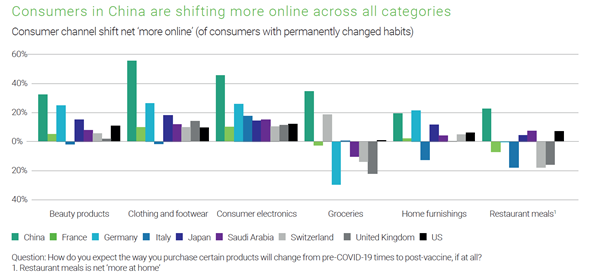自疫情爆发以来,中国线上食杂零售领域增长势头强劲。2020年当年销售额实现了62%的高速增长,2021年销售额增长约为25%。尽管增速有所放缓,但线上渠道的重要性毋庸置疑。预计未来3-4年该领域将持续增长,年增长率在13-25%之间。
Growth in the online grocery space in China has been strong since the pandemic with 62% growth in 2020. In 2021, the growth is estimated to be at ~25%. Though this was a slowdown, there is no doubt that the online channel will become increasingly important. The segment is expected to grow between 13-25% per annum over the next 3-4 years.
艾睿铂于2021年进行的一项全球调查(见文末“阅读文章”链接) 显示,中国消费者在从线下向线上购物渠道的转换方面表现最为“激进”。这在"食杂"品类中表现得尤为明显,在其他国家的大多数消费者出现向线下购物回归的净流向时,中国消费者则明显倾向从线下转为线上。
In a survey conducted globally by AlixPartners in 2021 (link to article), consumers in China were seen to be the most “aggressive” in shifting their purchasing online. This was especially so in the “Groceries” category where most consumers from other countries saw a net shift back to offline buying.

由上图可见,中国消费者积极拥抱数字化,并且越来越注重便利性。因此,线下食杂零售商、纯线上食杂供应商和第三方平台开发了不同的线上交付模式,以满足消费者对便利性的需求。
 As seen, the Chinese consumer is clearly digitally savvy and has increasingly been more focused on convenience. As such, offline grocery players, purely online grocery providers and third-party platforms have developed different online delivery models to fulfill this need for convenience.
As seen, the Chinese consumer is clearly digitally savvy and has increasingly been more focused on convenience. As such, offline grocery players, purely online grocery providers and third-party platforms have developed different online delivery models to fulfill this need for convenience.
在线下食杂零售商领域,永辉等传统零售商一直专注于加强其线上业务,并推出配送服务,以期从现有客户中获得更大的市场份额。
In the offline grocery players space, traditional retailers such as Yonghui have focused on beefing up their online presence and have also developed their express delivery options to gain a larger market share among existing customers.
科技巨头阿里巴巴(Alibaba)推出的零售商超盒马鲜生(Freshippo)专注于利用其强大的线上能力,提供围绕送货上门服务的全渠道无缝体验,同时以线下门店作为补充。
Freshippo, a retailer launched by tech giant Alibaba has focused on leveraging its strong online capabilities to offer a seamless omnichannel offering centered around home delivery whilst building out its offline presence as well.
每日优鲜(MissFresh)和叮咚买菜(Dingdong)等纯线上食杂供应商也试图通过提供快速的配送服务来满足人们对便利性的需求,配送员通常可在30-40分钟内从前进仓(DMV)出发完成订单交付。
Purely online grocery providers such as MissFresh and Dingdong have also sought to fill this need for convenience by providing express delivery services, with orders being filled from their Distributed Mini Warehouses (DMVs) usually within 30-40 mins.
第三方平台为小型食杂连锁店和供应商提供了有力支持。京东(JD.com)推出的京东超市/京东到家在中国的销售额和覆盖范围不断扩大(在中国1400个城市实现一小时内送达)。此外,饿了么和美团这样的平台提供的配送服务也经常成为许多消费者和零售商解决“最后一公里配送”的选择。
Third party platforms act as enablers for smaller grocery chains and providers. JD.com launcher JD Supermarket/JD Daojia and has seen increasing sales and reach throughout China (one hour delivery across 1,400 cities in China). In addition, these platforms (Ele.me and Meituan) often act as the “last mile delivery” options for many consumers and retailers alike.
近期,这些第三方平台也开始提供“社区团购”。然而,市场也见证了某些早期尝试者的失败,该模式的前景仍有待探讨。
In recent times, these third party platforms have also started to offer “Community Group Buys”. However, the viability of this model is still being ascertained as the market has witnessed the failure of certain early adopters.
当不同的市场参与者探索更便利的交付模式的同时,他们也应当思考如何更好的发展企业核心竞争力。消费者对“更快配送”的需求固然很重要,但随着线上渠道的日益成熟,其他方面的需求也不容忽视。线上食杂零售供应商应着眼未来,发展出送货上门模式之外的其他核心能力,提出吸引和留住消费者的价值主张,以实现业务长期增长。
As different players in China explore the various models to best fulfill this need, one must consider how best to balance the insatiable demand for being “quicker” and other increasing consumer demand. Online grocery providers should start to develop core capabilities beyond the home delivery that present a value proposition, which attracts and retains consumer to enable long term growth.
